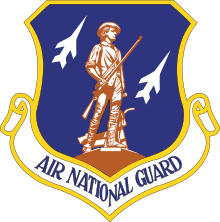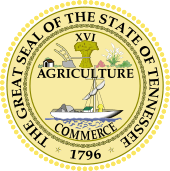155th Airlift Squadron
The 155th Airlift Squadron (155 AS) is a unit of the Tennessee Air National Guard 164th Airlift Wing. It is assigned to Memphis Air National Guard Base, Tennessee and is equipped with the Boeing C-17 aircraft.
| 155th Airlift Squadron | |
|---|---|
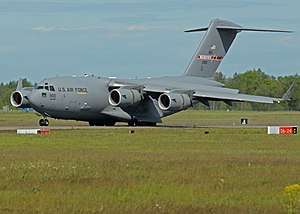 155th Airlift Squadron C-17 Globemaster III | |
| Active | 12 December 1942–Present |
| Country | |
| Allegiance | |
| Branch | |
| Type | Squadron |
| Role | Airlift |
| Part of | Tennessee Air National Guard |
| Garrison/HQ | Memphis Air National Guard Base, Memphis, Tennessee |
| Nickname(s) | "Memphis Belle" |
| Tail Code | Red tail stripe, "Memphis" in white letters |
| Battle honours | World War II Vietnam Conflict |
| Insignia | |
| 155th Airlift Squadron emblem | 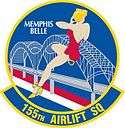 |
History
World War II
Organized and trained in the Northeast United States by First Air Force. During training was part of the air defense of the northeast, being attached to the New York and Boston Fighter Wings.
Deployed to England aboard the RMS Queen Elizabeth and served in combat as part of VIII Fighter Command from October 1943 to May 1945, participating in operations that prepared for the invasion of the Continent, and supporting the landings in Normandy and the subsequent Allied drive across France and Germany. The squadron flew P-47 Thunderbolts until they were replaced by P-51 Mustangs in November 1944.
From October 1943 until January 1944, operated as escort for B-17 Flying Fortress/B-24 Liberator bombers that attacked such objectives as industrial areas, missile sites, airfields, and communications.
Fighters from the 461st engaged primarily in bombing and strafing missions after 3 January 1944, with its targets including U-boat installations, barges, shipyards, aerodromes, hangars, marshalling yards, locomotives, trucks, oil facilities, flak towers, and radar stations. Bombed and strafed in the Arnhem, Netherlands area on 17, 18, and 23 September 1944 to neutralize enemy gun emplacements providing support to Allied ground forces during Operation Market-Garden. In early 1945, the squadron's P-51 Mustangs clashed with German Me 262 jet aircraft. The squadron flew its last combat mission, escorting B-17's dropping propaganda leaflets, on 7 May 1945.
Remained in the United Kingdom during the balance of 1945, most personnel were demobilized and returned to the United States, with aircraft being sent to storage facilities in the UK. The squadron was administratively inactivated at Camp Kilmer New Jersey on 10 November 1945 without personnel or equipment.
Tennessee Air National Guard
Re-designated: 155th Fighter Squadron, and allotted to Tennessee ANG, on 24 May 1946, extended federal recognition and activated on 3 February 1947. Assigned to the 118th Fighter Group at Berry Field, Nashville, flying the P-47 Thunderbolt aircraft. Was converted to a Tactical Reconnaissance Squadron in February 1951, being re-equipped with the RB-26 Invader.
Was Federalized and placed on active duty, 2 March 1951, remaining at Memphis Municipal Airport. Released from active duty and returned to Tennessee state control, 31 December 1952. The unit was redesignated as a jet photo reconnaissance organization on 1 April 1956 and equipped with the RF-84 Thunderflash, the jets being received directly from the factory for use in this mission.
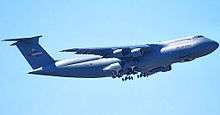
Was expanded and the organization in Memphis was upgraded to a Group level on 1 April 1961, the squadron being assigned to the new 164th Military Airlift Group. Was realigned to becoming a strategic transport unit under Military Air Transport Service, being equipped with C-97 Stratofreighters. Conversion to this aircraft brought a worldwide mission with operations to such places as Europe, Japan, South America, Australia and South Vietnam.
During May 1966, the unit set numerous records, to include 10 round trips to Southeast Asia and 1702 flying hours in one month, all accomplished primarily dedicated part-time personnel. May 1967 brought the introduction of the C-124 Globemaster, affectionately known as "Old Shakey". Along with Old Shakey, the squadron's personnel performed numerous humanitarian missions as well as routine support to Military Airlift Command (MAC).
The C-124 was given a well-deserved rest in 1974 when she was retired from military service, reluctantly giving up her berth to the C-130 Hercules. The C-130s were transferred to other units in April 1992 when the unit received the first of eight C-141 Starlifter aircraft. In 2004, the squadron retired the C-141 and began operate the C-5A Galaxy. 18 December 2012 the 1st C-17A of 8 arrived.
Lineage
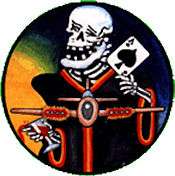
- Constituted as 359th Fighter Squadron on 8 December 1942
- Activated on 12 December 1942
- Inactivated on 10 November 1945
- Re-designated: 155th Fighter Squadron, and allotted to Tennessee ANG, on 24 May 1946.
- Extended federal recognition and activated on 3 February 1947
- Re-designated as: 155th Tactical Reconnaissance Squadron (Night Photographic), 1 February 1951
- Federalized and placed on active duty, 2 March 1951
- Released from active duty and returned to Tennessee state control, 31 December 1952
- Re-designated as: 155th Tactical Reconnaissance Squadron (Jet), 1 April 1956
- Re-designated as: 155th Air Transport Squadron, 1 April 1961
- Re-designated as: 155th Military Airlift Squadron, 8 January 1966
- Re-designated as: 155th Tactical Airlift Squadron, 1 August 1974
- Re-designated as: 155th Airlift Squadron, 16 April 1992
- Re-designated as: 155th Airlift Squadron, 1 October 1995
Assignments
- 356th Fighter Group, 12 Dec 1942 – 10 Nov 1945
- 118th Fighter Group, 3 February 1947
- 118th Composite Group, 1 September 1950
- 118th Tactical Reconnaissance Group, 1 February 1951
- 164th Air Transport Group, 1 April 1961
- 164th Military Airlift Group, 8 January 1966
- 164th Tactical Airlift Group, 1 August 1974
- 164th Airlift Group, 16 April 1992
- 164th Airlift Wing, 1 October 1995
Stations
|
|
Aircraft
|
|
Aircraft flying in this unit
C-17A
94-0065 (Dec15); 95-0104 (Dec15); 97-0042 (Dec15); 02-1100 (Dec15)
References
![]()
- Maurer, Maurer. Combat Squadrons of the Air Force: World War II. Maxwell Air Force Base, Alabama: Office of Air Force History, 1982.
- 164th Airlift Wing history page
- 164th Airlift Wing@globalsecurity.org
- Rogers, B. (2006). United States Air Force Unit Designations Since 1978. ISBN 1-85780-197-0
